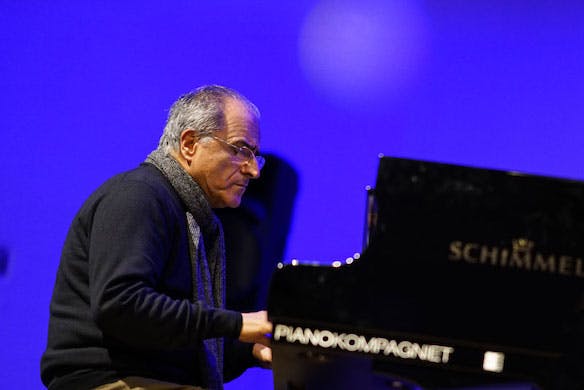Stirring the Three-Continent Cauldron of Jazz
A major contemporary pianist from Rome has taken the gift that John Lewis gave to us and is paying it forward.

Enrico Pieranunzi Trio & Orchestra Filarmonica Italiana conducted by Michele Corcella
‘Blues & Bach – The Music of John Lewis’ (Challenge Records)
The basic story we are taught about the origins of jazz in America is that it was the result of a dual set of influences from Africa and Europe. The new album by the brilliant Italian pianist Enrico Pieranunzi, “Blues & Bach – The Music of John Lewis,” illustrates how those currents flow among the three continents to this day, and how they’re interacting and intermingling to produce remarkable new music.
If there’s one musician whose work makes this point crystal clear, it would have to be John Lewis (1920-2001) and his ensemble, the Modern Jazz Quartet — and no, it’s not at all surprising that the jazzman who most thoroughly explored the European aspects of the music was not himself of what we would call European descent, but rather was an African American pianist, composer, and bandleader. Now, a major contemporary pianist from Rome has taken the gift that Lewis gave to us and is paying it forward.
Seven of the eight tracks on “Blues & Bach” are well-known compositions by Lewis for the MJQ. They’re reinterpreted by the combination of Signor Pieranunzi’s trio, with bassist Luca Bulgarelli and drummer Mauro Beggio, and the Orchestra Filarmonica Italiana conducted by Michele Corcella. The music is reimagined by the Trio against a backdrop of five strings plus five woodwinds and horns; it’s a relatively small ensemble by classical standards, but more than large enough for the purpose.
It can’t be a coincidence that the majority of the Lewis compositions here reference Old World culture and geography, starting with their titles: “Spanish Steps,” “Vendome,” “Django,” “Concorde,” and “Milano.” Lewis was, in fact, the jazz composer who made the most overt use of baroque-era concepts like fugue and counterpoint, and who referenced Bach and Mozart as much as Ellington and Monk.
“Django,” which might be Lewis’s most famous work, represents a complex web of cultural cross currents all by itself. As the title makes clear, it was inspired by the first great non-American jazz soloist, the legendary Romany guitarist Django Reinhardt, who was himself inspired by Americans such as Eddie Lang and Louis Armstrong.
The classic MJQ recording opens with a guitar-like phrase, while the new version starts with an elaborate but subtle introduction by the full orchestra before we hear those iconic notes, as played by Signor Pieranunzi. As soon as that melody has been established, the strings and woodwinds swell up abruptly, then a big grandiose flourish leads to a very jazzy keyboard improvisation by the Trio, including a bass solo. Eventually, the strings re-enter and signal a ritard as they slow back down into the ending theme.
“Skating in Central Park” doesn’t have any European references in the title, but the piece is very much an old-school waltz — as distinct from the new-style “jazz waltzes” (in 6/8 or 6/4 rather than 3/4) that were already being heard in 1959. Lewis composed it as part of the score for the film noir “Odds Against Tomorrow,” and as such, recorded it with both a full orchestra and the MJQ. Signors Pieranunzi and Corcella apparently reconcile both of those and turn it into something completely new, a piece that is both lyrical and swinging and suggests skimming over the ice in an elongated circle, in which both the piano and the bass occasionally peek out from the larger ensemble for solo spots.
“Autumn in New York” represents yet more panglobalism; the most overtly American number here was written by the Russian-born songwriter and composer Vernon Duke (née Vladimir Aleksandrovich Dukelsky). It seems churlish to state that the MJQ’s classic interpretation is the best of the hundreds of jazz recordings of Duke’s standard, but it’s always been my go-to version.
The original 1953 recording starts with a brief, chamber-style intro before proceeding into the familiar tune, but the new re-interpretation starts with Signor Pieranunzi playing the melody itself slow and legato as a kind of an introduction. As we approach the end of that first chorus, he slows down even further to heighten the tension; then there’s a pause before we abruptly leap back into the tune at full force and at a swinging tempo.
The final and the newest piece is “Under the Jasmine Tree,” from the MJQ’s eponymous 1968 album. It was originally released on the Beatles’ Apple music label, where they were the only jazz act. Apparently the Fab Four themselves weren’t responsible for the signing, but it’s tempting to draw parallels between an American-influenced British rock band and a European-influenced African-American jazz ensemble.
Reflecting an anarchic era, “Jasmine Tree” is a relatively wild-and-wooly piece by Q standards. It’s a funky, gospel-y hootenanny, complete with tambourine, and yet it also suggests the nutso time signatures popularized in jazz by Dave Brubeck and later Don Ellis. The new version begins with the drums and then the Trio before the whole orchestra comes in with an energetically swirling mass of sound; Lewis originally wrote it for a documentary about Morocco, and the new version sounds even more Middle Eastern than the original. You might call it a “Blue Rondo a la Bach.”

